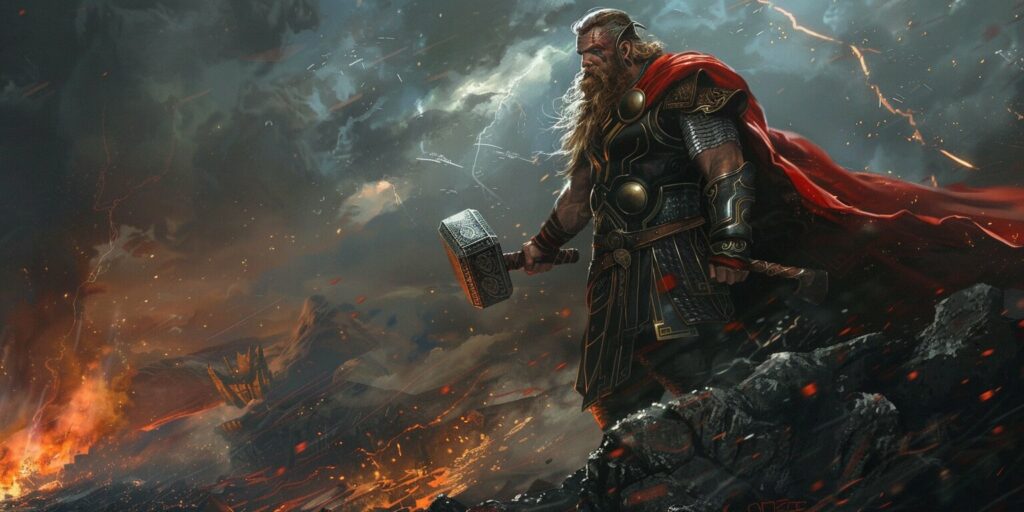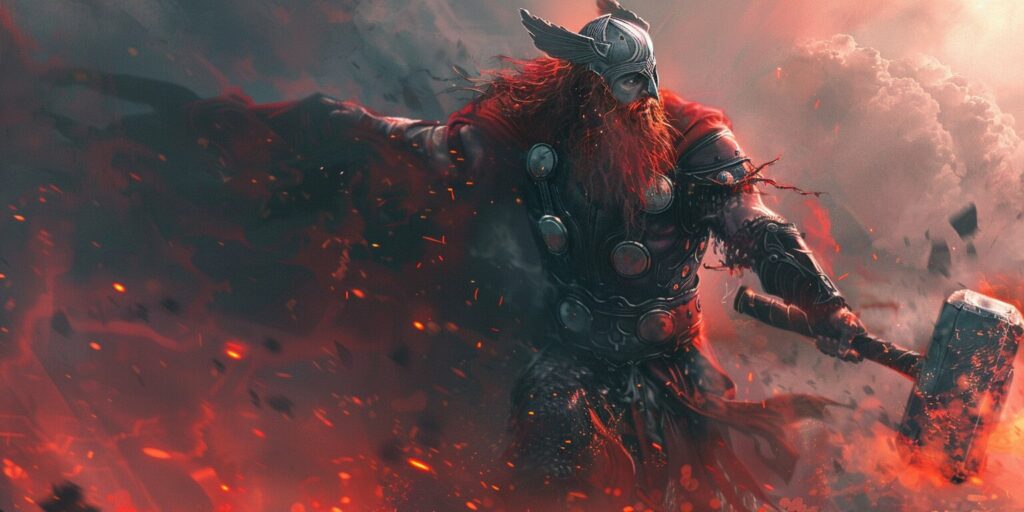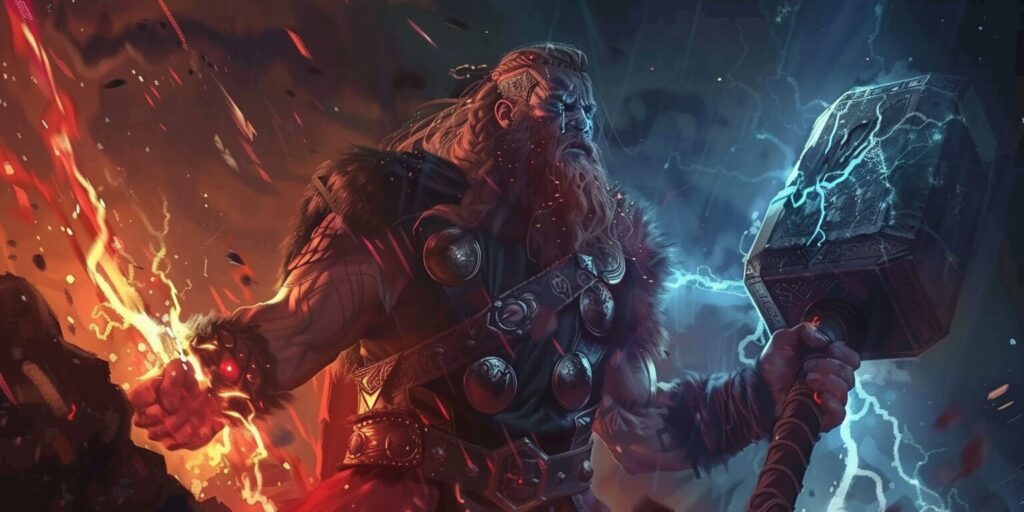The Norse god Thor is one of the most powerful and well-known deities in the rich tapestry of Norse mythology. However, the portrayal of his physical appearance has been a subject of much debate and confusion. Despite the persistent myth of Thor being depicted as an overweight or obese figure, the primary sources of Norse mythology, such as the Poetic Edda and the Prose Edda, paint a strikingly different picture of the god of thunder and lightning.
In this article, we will delve into the historical and mythological evidence to uncover the true depiction of Thor’s physique, debunking the long-standing notion of him being a “fat” or heavily overweight deity. By examining the original sources and exploring the various representations of Thor in Norse mythology, we aim to provide a comprehensive understanding of the god’s actual physical description and challenge the misconceptions that have taken root in popular culture and media adaptations. So, is Thor fat in mythology? Keep reading to find out!
Who is Thor in Norse Mythology?
Thor, the god of thunder, lightning, storms, oak trees, strength, the protection of mankind, and fertility, is one of the most prominent and powerful deities in Norse mythology. As the son of the chief god Odin and the earth goddess Jörð (or Fjörgyn), Thor is a member of the Aesir, the principal group of gods in the Norse pantheon.

Thor – The God of Thunder and Lightning
Thor is a central figure in Norse mythology. He is known for his immense strength and wielding the mighty hammer Mjolnir. He is responsible for defending the gods, the heavenly realm of Asgard, and humanity from the threats of giants, trolls, and other malevolent forces.
Thor’s Role in Norse Mythology
Thor’s role in Norse mythology is multifaceted. He is not only the god of thunder and lightning but also a protector of the Aesir and a fertility deity. His legendary battles against the giants, his unwavering loyalty to Odin, and his importance in the prophesied events of Ragnarok have cemented his status as one of the most revered and powerful figures in the Norse mythos.
Dispelling the Myth of Thor Being Fat
Despite the persistent myth of Thor being depicted as an overweight or obese figure, the primary sources of Norse mythology do not actually support this portrayal. In the Poetic Edda and the Prose Edda, the two main literary sources for Norse mythology, Thor is consistently described as a physically powerful and muscular deity rather than a fat or overweight one.
Examining Thor’s Physique in Norse Mythology
What is Thor supposed to look like? The textual evidence from the original Norse mythology sources paints a clear picture of Thor as a physically imposing and muscular figure, not the fat or overweight version often depicted in popular culture and modern adaptations. The Eddas, the primary source for Norse mythology, describes Thor as a deity with immense strength and power, befitting his role as the god of thunder, not as Thor is really fat.
Comparing Different Depictions of Thor
While some modern interpretations of Thor, such as in the MCU (Marvel Cinematic Universe) films, have portrayed him as a muscular and physically imposing figure, the myth of him being fat or overweight persists in certain popular culture depictions. The original Norse mythology sources do not support this myth, which consistently describes Thor as a heavily built and powerful deity.
Separating Fact from Fiction: Was Thor Actually Fat?
The evidence from the original Norse mythology sources overwhelmingly suggests that Thor was not actually fat or overweight, as is sometimes claimed. The Eddas and other Norse mythology texts present Thor as a physically imposing and muscular deity whose appearance and depiction are accurate to the original Norse mythos, with no reference to Thor being fat in Norse mythology. The myth of Thor being fat or overweight is, therefore, a myth busted by the primary sources of Norse mythology.
Thor in Popular Culture: From Mythology to Movies
The character of Thor has become increasingly prominent in popular culture, particularly through his appearances in various movies, TV shows, and video games. These modern interpretations of the Norse god have significantly impacted the public’s perception of Thor’s physical appearance and characteristics, often diverging from the traditional Thor look described in ancient texts.
Thor’s Portrayal in Movies and TV Shows
In recent years, the MCU (Marvel Cinematic Universe) has brought the character of Thor to the big screen, with actor Chris Hemsworth portraying the mighty god of thunder. Hemsworth’s depiction of Thor has become the most widely recognized version of the character, with his muscular, chiseled physique aligning more closely with the descriptions found in Norse mythology than the “fat Thor” trope that has sometimes surfaced in popular culture.

Beyond the MCU, other adaptations of Thor in movies and TV shows have also shaped the public’s perception of the Norse god’s appearance, often departing from the Thor look in traditional lore. From the striking visuals of the God of War Ragnarok video game to the powerful presence of Thor in various animated series, these modern interpretations have helped cement Thor’s image as a physically imposing, heroic figure.
Impact of Marvel’s Thor on Public Perception
The success of the MCU’s Thor franchise, particularly the films Endgame and Thor: Ragnarok, has significantly impacted the public’s perception of the Norse god. Chris Hemsworth’s portrayal of Thor, with his chiseled physique and impressive stature, has become the dominant image of the character in the minds of many moviegoers and fans of the MCU.
This visual representation has, to some extent, overshadowed the more diverse interpretations of Thor’s appearance found in the original Norse mythology. While the MCU’s version of Thor may not be entirely accurate to the original mythological sources, it has undoubtedly contributed to a more widespread and recognizable image of the god of thunder in popular culture.
Influence of Thor in Norse Culture
Thor’s influence and significance in Norse culture and mythology cannot be overstated. As one of the most powerful and revered deities in the Norse pantheon, Thor played a central role in the religious and cultural beliefs of the Viking peoples, embodying the ideals and physical prowess admired by the gods’ followers.
Thor’s Significance in Norse Society
As the god of thunder, lightning, storms, oak trees, strength, the protection of mankind, and fertility, Thor’s importance in the lives of the Norse people cannot be overstated. He was a deeply revered and feared deity, with his mighty hammer, Mjölnir, symbolizing his power and the assurance of security for the Aesir gods and the people they protected.
Thor’s Characteristics in Norse Mythology
In the Norse mythos, as depicted in the Poetic Edda and the Prose Edda, Thor is often described as a physically imposing and heavily built deity with a commanding presence that befitted his status as a god of strength and power. His characteristic red hair, beard, and affinity for feasting and revelry further cemented his image as a larger-than-life figure in the Norse pantheon.

Thor’s Representation in Viking Art and Literature
The influence of Thor can also be seen in the rich tapestry of Viking art and literature, where he is frequently depicted as a central figure, showcasing what Thor really looked like in Norse mythology. From the intricate carvings and illustrations in the Eddas to the numerous references to his deeds and exploits in sagas and poems, Thor’s presence is a constant throughout the Norse mythos, solidifying his position as a deity of immense importance and power.
The Evolution of Thor’s Image Over Time
The depiction of Thor, the mighty Norse god, has undergone a remarkable transformation throughout history, from the revered Norse myth figure to the modern interpretation, yet always maintaining the core attributes that resonate with the gods’ essence. Initially, in the original Norse mythology, Thor was often depicted as a physically imposing and heavily built deity with a muscular physique that embodied his immense strength and power. Contrary to popular belief, there were no descriptions of Thor being actually fat in Norse mythology.
Changes in Thor’s Appearance in Different Eras
As the centuries passed, the image of Thor evolved, reflecting the changing cultural and artistic influences. In Viking art and literature, Thor was often portrayed with distinctive features, such as his iconic hammer, Mjölnir, and fiery red hair and beard, and not as was Thor fat in Norse mythology, debunking myths about his size. These visual cues were central to the way Thor was perceived and represented in the Norse mythos, significantly shaping the Thor look in the collective imagination.
Modern Interpretations of Thor in Popular Culture
The modern interpretations of Thor, particularly in the Marvel Cinematic Universe (MCU) and other popular media, have significantly impacted the public’s perception of the Norse god. The portrayal of Thor as a ruggedly handsome, muscular, and heroic figure has become the predominant image in contemporary society, often diverging from the more traditional depictions found in the original Eddas and Norse mythology.
Thor’s Symbolism in Contemporary Society
Despite these variations, Thor’s core essence—his strength, power, and role as the protector of the gods and humanity—has remained constant. Thor’s symbolism and influence continue to be felt in contemporary society, where he is often seen as a representation of masculine prowess, leadership, and the enduring legacy of Norse mythology.
Summary
In our exploration of the myths and misconceptions surrounding the physical appearance of the Norse god Thor, we have uncovered the true depiction of this powerful deity as portrayed in the primary sources of Norse mythology. Contrary to the persistent notion of Thor being an overweight or obese figure, the Poetic Edda and the Prose Edda consistently describe him as a physically imposing and muscular deity, befitting his role as the god of thunder, lightning, and strength.
The evidence from these foundational texts clearly debunks the myth of Thor being a “fat” or overweight god in Norse mythology. Instead, the primary sources paint a vivid picture of Thor as a formidable and athletically built figure with a physique that commands respect and awe. This accurate portrayal of Thor’s appearance starkly contrasts the modern interpretations and popular culture depictions that have sometimes perpetuated the erroneous notion of him being an obese or heavily overweight deity.
By delving into the historical and mythological sources, we have been able to separate fact from fiction and provide a comprehensive understanding of Thor’s physical description as depicted in the original Norse mythos. This exploration has allowed us to dismantle the persistent myth of Thor being a “fat” god and to align our understanding with the primary textual evidence that showcases him as a powerful, muscular, and physically imposing figure in Norse mythology.

